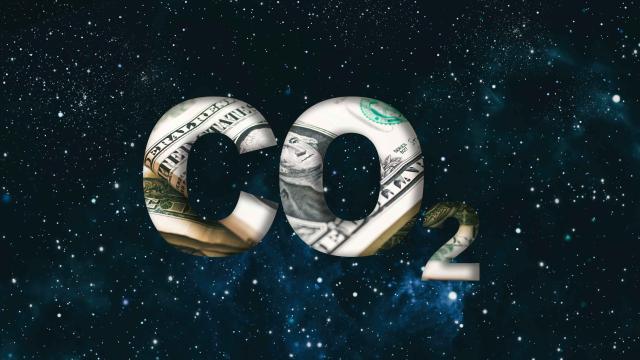
Rystad data points to the possibility of profitability in carbon capture. (Source: Hart Energy; rafastockbr, Zakharchuks/Shutterstock.com)
Will the rising cost of emitting carbon and the falling cost of carbon capture and storage (CCS) ultimately turn the economics of emissions on its head?
While Susanne Andresen, senior analyst for global energy systems at Rystad Energy, acknowledges that CCS is an expensive option for emitters, that doesn’t mean they can’t ultimately become profit centers. During a recent webinar, she described what Rystad’s pricing models show.
“If you know that emitting will become increasingly expensive, you will probably choose to inherently decarbonize your process as much as possible because it’s typically just more economically attractive,” Andresen said. “But you’ll do that until you reach the cost of CCS, and until you reach the cost of CCS, you’ll choose other options. Essentially, CCS is the option of last resort.”
A lot of the modeling depends on the region. For example, Oslo-based Rystad calculated the offshore Norway levelized cost of CCS to be around $120 per tonne of CO2. Real-world prices are already down to about $100 per ton, she said. However, Norway’s government has committed to enacting a carbon tax of about $237 per tonne of CO2 by 2030 as part of its plan to cut greenhouse-gas emissions by 50%-55% by 2030 compared to 1990 levels.
In those parameters, it would cost about half or less than half as much to capture carbon than to emit it.
Picture imperfect
Rystad modeled an onshore U.S. price of about $70 a tonne, a calculation reinforced by the reported $75 a ton at the Petra Nova CCS project in Texas. By 2026, the 45Q incentive program will provide up to $50 per ton for CO2 that is geologically sequestered. That would lower the cost of CCS to about $25 per ton, or just $10 above a $15 flat national carbon tax that has been batted around the halls of Congress.
“If we take this a step further, we consider the Clean Energy Payment Program (CEPP) that’s currently on the table,” Andresen said. CEPP, a part of President Joe Biden’s Build Back Better bill, would increase the 45Q incentive to about $85 per tonne by 2026. “So, costs are $75 per tonne, the incentive becomes $85 per tonne—this actually presents an attractive picture.”
This picture, at this point, is not perfect. The Petra Nova CCS plant was shut down by NRG Energy Inc. in 2020 when low oil prices made the project no longer economically viable. Petra Nova had shipped the carbon it captured to an oil field for use in EOR. The coal-fired power plant attached to the project was shut down earlier this year. The project, a joint venture between NRG and JX Nippon of Japan, was supported by a $190 million grant from the U.S. Department of Energy.
Then there is the CEPP. The $150 billion program remains part of Biden’s Build Back Better legislative proposal but is opposed by Sen. Joe Manchin (D-W.Va.), making its ultimate inclusion somewhat doubtful.
Carrot or stick?
The most effective approach for government to take isn’t entirely clear. Carrot or stick?
“The thing that I always worry about with the stick—and by stick I mean things like technology mandates or requirements to use CCUS—the thing that I always worry about is that the stick, or at least what the stick looks like in my mind, you wind up picking a winner,” Seth Blumsack, professor of energy and environmental economics and international affairs at Penn State, told Hart Energy earlier this year. “Maybe CCUS is a really good option, maybe increasing deployment of energy storage so you can use more renewables in a more firm way winds up being a better option.”
What worries Blumsack is that, by picking technology winners, the government winds up effectively pre-empting what could be a better option in the future.
But while he has concerns about the approach, Blumsack also said a policy that is serious about both decarbonization and having a reliable power grid requires taking carbon capture pretty seriously.
“Whether it’s a carrot or a stick,” he said, “we need to find ways to actually figure out how to do this on the ground and scale.”
Recommended Reading
Marathon Petroleum Sets 2024 Capex at $1.25 Billion
2024-01-30 - Marathon Petroleum Corp. eyes standalone capex at $1.25 billion in 2024, down 10% compared to $1.4 billion in 2023 as it focuses on cost reduction and margin enhancement projects.
Humble Midstream II, Quantum Capital Form Partnership for Infrastructure Projects
2024-01-30 - Humble Midstream II Partners and Quantum Capital Group’s partnership will promote a focus on energy transition infrastructure.
BP’s Kate Thomson Promoted to CFO, Joins Board
2024-02-05 - Before becoming BP’s interim CFO in September 2023, Kate Thomson served as senior vice president of finance for production and operations.
Magnolia Oil & Gas Hikes Quarterly Cash Dividend by 13%
2024-02-05 - Magnolia’s dividend will rise 13% to $0.13 per share, the company said.
TPG Adds Lebovitz as Head of Infrastructure for Climate Investing Platform
2024-02-07 - TPG Rise Climate was launched in 2021 to make investments across asset classes in climate solutions globally.






